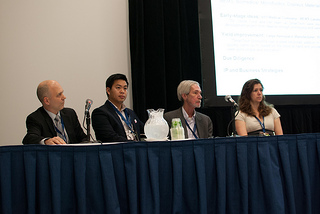by Monica Takacs, Director of Membership, MEMS Industry Group
February 2014, MEMS Industry Group (MIG) exhibited at the MD&M West conference and tradeshow in Anaheim, CA with MIG members AM Fitzgerald & Associates, IMT – Innovative Micro Technology and Silex Microsystems as our co-exhibitors. Our host for the microtechnology pavilion was IVAM Microtechnology Network, one of our 26 partner organizations, and it featured international companies involved in the manufacturing of MEMS, sensors and printed electronics for the medical device industry.
Medical device manufacturers have quickly noticed MEMS as a viable solution to include in their multi-functional next-generation products. With MEMS steadily making its way into more medical applications, MIG is creating opportunities for our members to connect with the medical device community. In addition to attending and creating content for medical-device shows, we are launching members-only programming such as the MEMS in Healthcare Working Group, launched in the fall of 2013.
At MD&M West, MIG hosted a Learning Labs conference session, “Advanced Application of Sensors in Medical Devices,” with MIG Governing Council Member Alissa M. Fitzgerald, Ph.D., founder and managing member, A.M. Fitzgerald & Associates, LLC as the chair. A panel of MIG members IMT – Innovative Micro Technology, Merit Sensor, Silex Microsystems and Small Tech Consulting also participated in the panel discussion, “Utilizing new sensor technologies for implantable devices.”
 The panel discussed the MEMS ecosystem and advised medical-device companies on navigating the opportunities and challenges of MEMS product development. Counseling companies not to reinvent the wheel, panelists explained that they can leverage partner relationships to overcome the technical challenges of MEMS fabrication.
The panel discussed the MEMS ecosystem and advised medical-device companies on navigating the opportunities and challenges of MEMS product development. Counseling companies not to reinvent the wheel, panelists explained that they can leverage partner relationships to overcome the technical challenges of MEMS fabrication.
They also described the evolution of the MEMS industry over the last 10 years from a landscape of startup companies to Fortune 500 and even 100 companies now including MEMS in their product roadmaps. Michael Shillinger, founder of IMT remarked that the majority of IMT’s customer base is now made up of large companies rather than startups. Moderator Leslie Field, CEO of Small Tech Consulting, remarked how development cycles aren’t what they used to be, which has led to the ubiquity of MEMS.
Kevin Mach, senior account manager of Silex Microsystems cited the critical role of MEMS foundries in the massive adoption of MEMS over the last decade: “Companies planning to get into the medical/life science space need to reach out to MEMS foundries early and often. It’s important to understand what options are available in manufacturing and to leverage the technical expertise gained from years of MEMS processing. In our experience, customers that take the time to understand the capabilities and limitations of their partners tend to be successful long-term.”
Rick Russell, president of Merit Sensor, encouraged attendees to design MEMS for packaging, particularly with regard to implantables, which require lots of capital and are a challenge due to FDA regulations. Alissa Fitzgerald added that MEMS packaging for implantables is an opportunity for innovation and patents. Because MEMS is heading in the direction of commoditization, the value add is the packaging of the chip into the product, said Fitzgerald.
MIG members on the panel had their own takeaways:
“I was very impressed by the number of people who attended the panel, said Russell. “The overwhelming response showed me that innovators are eager to adopt more MEMS devices to help diagnose your physical state, whether it be your heart rate during a medical procedure or simply sharing your daily activity level on social media. The number of companies adopting MEMS for wearable devices (noninvasive) has exploded, but those that require FDA approval (invasive) are much slower to market but have a higher long-term reward.”
“I was excited to see so many people in the audience already aware of MEMS and thinking about how to use them in their products,” said Fitzgerald. “We need to have more interactions like this between medical device innovators and the MEMS industry. The more we can learn about each other’s needs and capabilities, the faster we’ll see exciting new medical products emerge.”
Listen to moderator Leslie Field discuss all of the key takeaways of the panel below.
Elsewhere on the show floor, MIG members were scattered throughout. Interlink Electronics showcased their force sensing technology, COTO Technology presented their RedRock MEMS Switch, which was awarded 2013 Product of the Year (MEMS category), by Electronic Products magazine, and Merit Sensor demoed their BP Series Blood Pressure Medical Sensor.
See both the Merit and Coto Technology product demos below.
